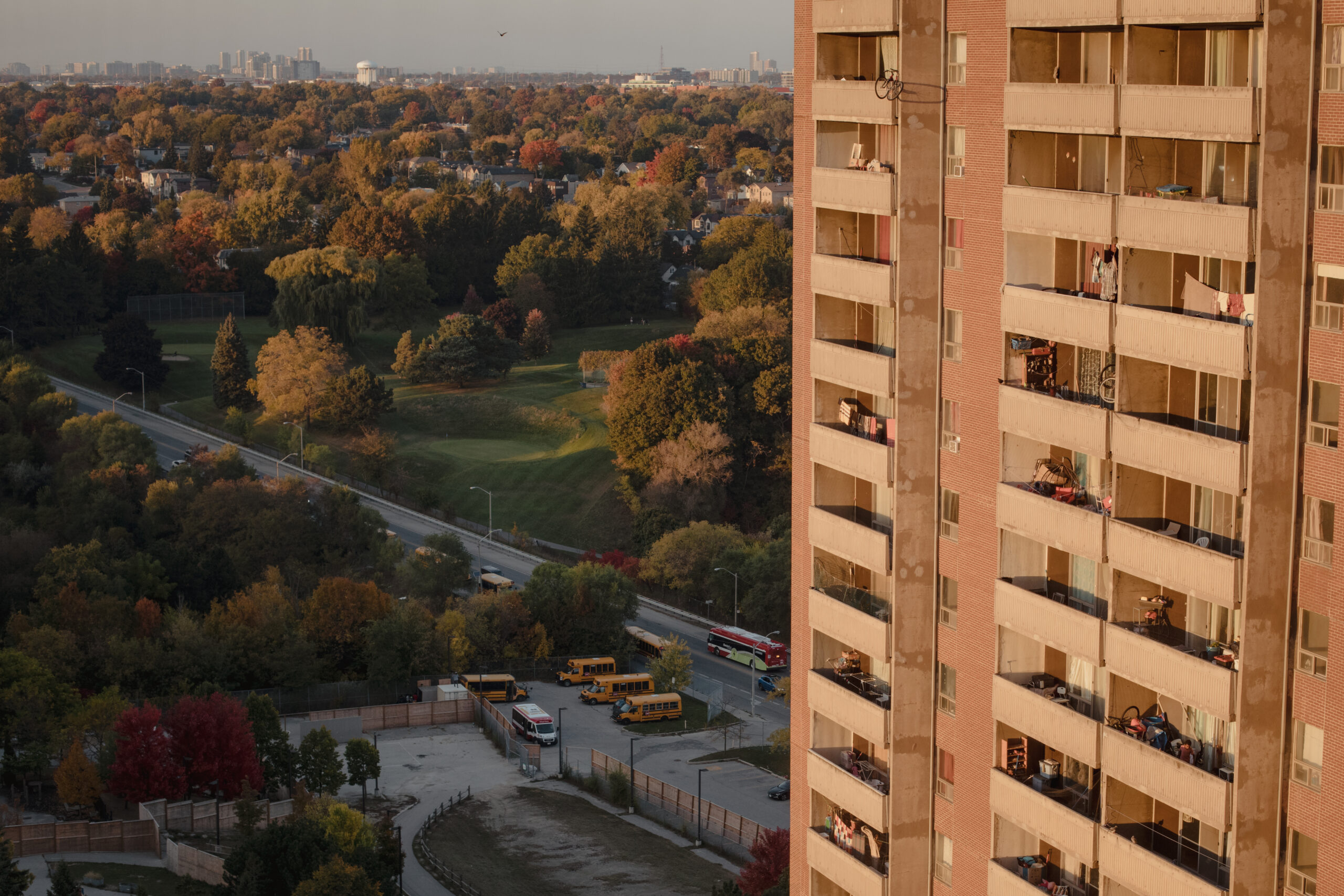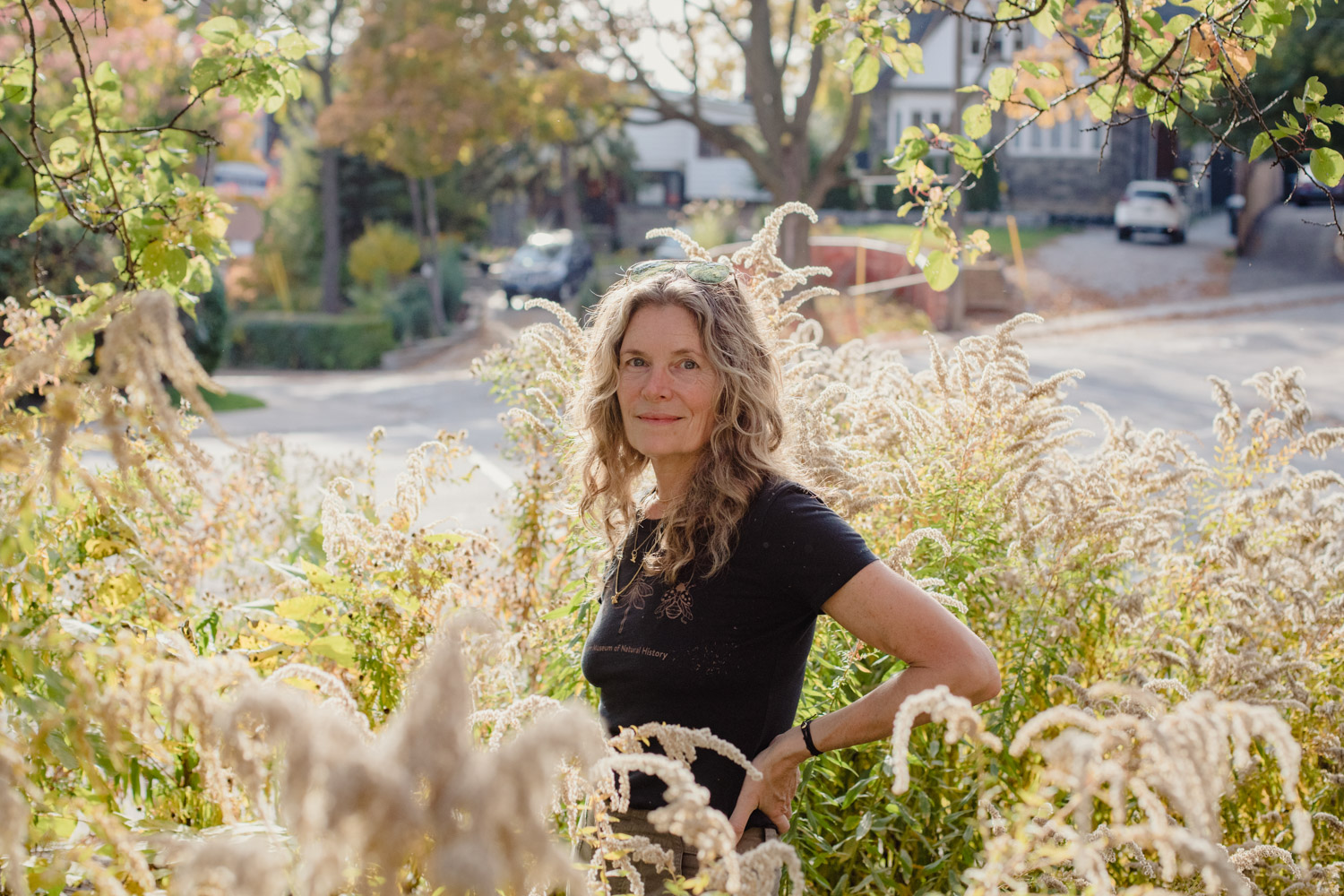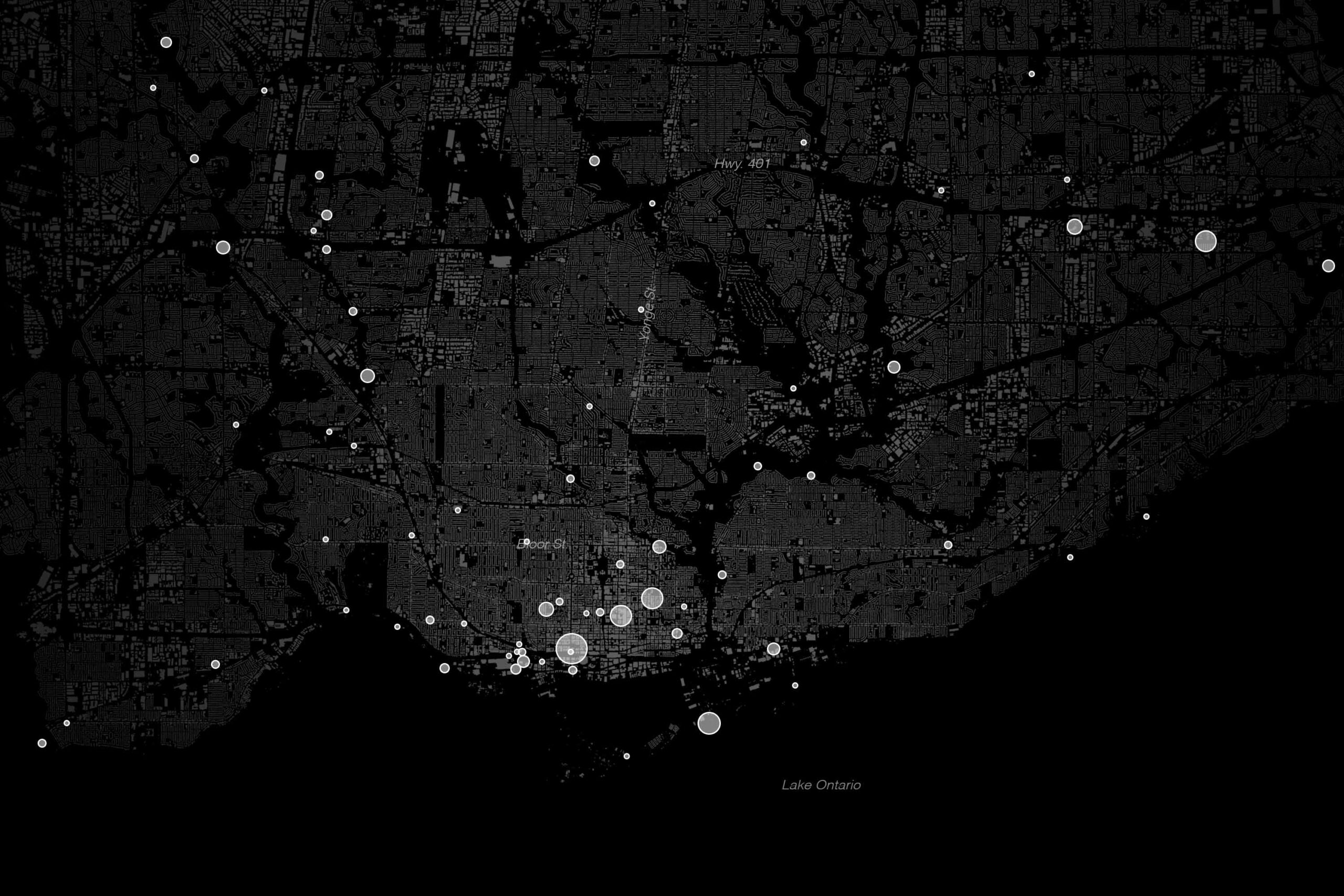Davit Sesisheili’s hands are thick and grimy, the nails yellowed and torn. Once, they inspected Toronto mansions—including Drake’s, he claims—for $60 an hour. Before that, they gripped the wheels of a long-haul truck in Philadelphia, sweated on Greek construction sites, and handled thousands of litres of homemade wine in his home country of Georgia. Ages ago, they held his son, now 11 years old. For the past year, they’ve sorted through piles of junk at Clarence Square Park, one of the largest homeless encampments in Toronto.
When I first met Sesisheili in May, you could find nearly anything scattered around his tent. There were baskets and Tim Hortons trays, milk crates, bicycles of dubious provenance, saucepans, a chest of harm reduction supplies like pipes and syringes, copper wire. A fat bottle of red wine sat near his tent, at odds with its surroundings. Between an adjacent tree, someone had hung laundry lines and curtains. Sesisheili is one of the most resourceful salvagers around. His food, clothes, and other life essentials are taken from donation bins around the city.
“I’ve seen a beautiful life…And I’ve seen a fucked-up life,” the 50-year-old says, in a voice so soft that my recorder occasionally struggles to capture it. Sesisheili is square and stocky, with a scruffy beard and perpetually worried eyes. He has a wry sense of humour and an old-school sense of propriety, standing to shake our hands whenever we arrive in camp.
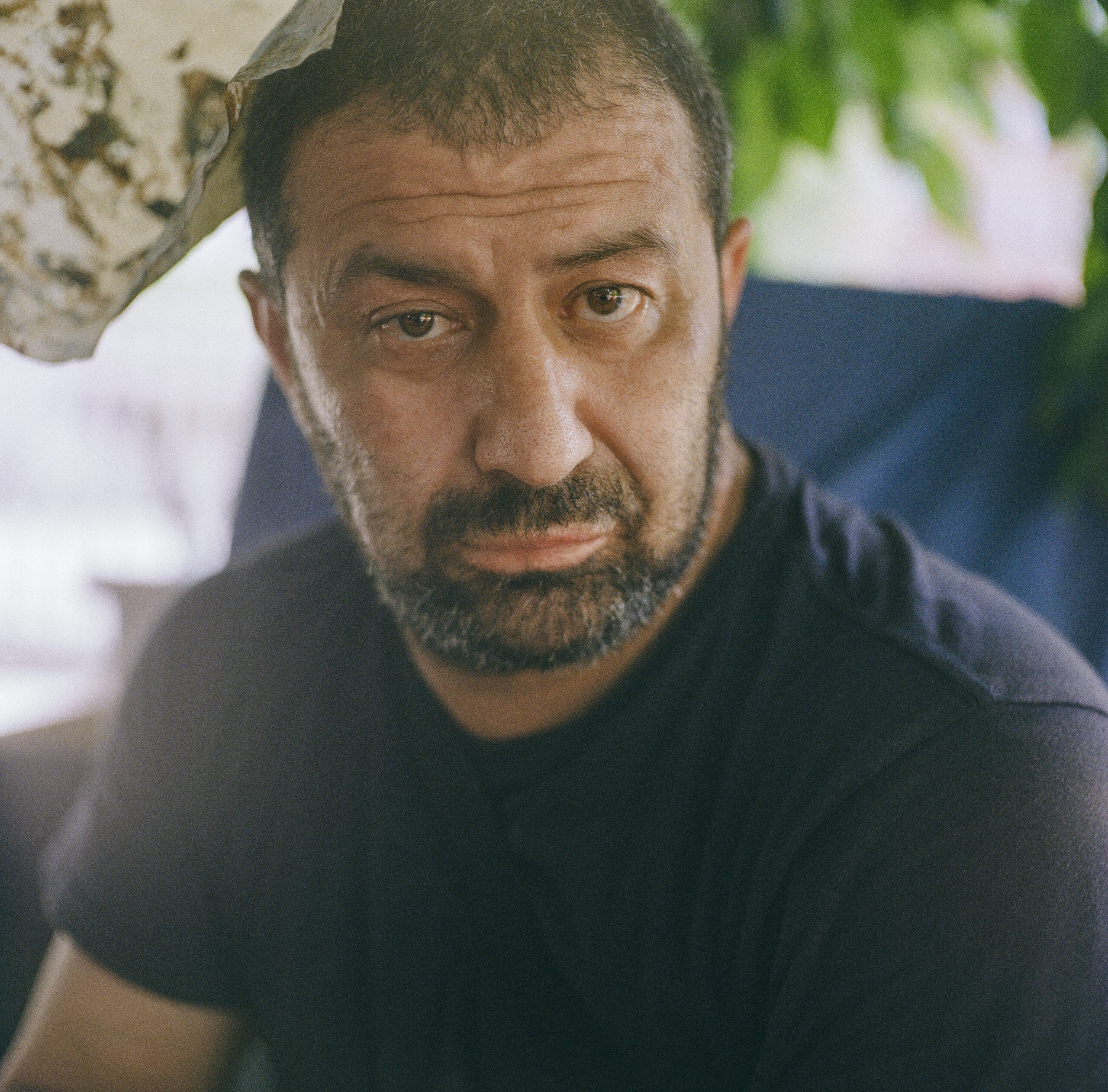
Conditions at Clarence Square can be challenging. When it rains, the well-trodden centre of the camp floods; during heat waves, there’s very little shade apart from tent canopies and Sesisheili’s tree. There are rat tunnels and garbage everywhere, although I never come across a used needle. Condo residents have complained of encampment residents defecating, and on one occasion masturbating, in the park itself. Violence is not uncommon.
Despite this, there is a sometimes dysfunctional, sometimes beautiful sense of community among the residents of Clarence Square Park. Regardless of their disagreements with each other, they’ll unfailingly come running in the event of an overdose, and—for better or worse—are quick to close ranks in the face of hostile outsiders, including those surreptitiously recording video footage as they walk by. Sesisheili is one of the most respected residents in the encampment’s community—someone who sets up total strangers with clothing, food, and even tents. But we hear stories of his capacity for violence, too. He’s survived knife fights. He’s had numerous stints in hospital: infections, burns, and treatment for psychosis (which he denies). No one living at Clarence Square Park is eager to cross him. In fact, we wouldn’t be welcome to roam amongst the tents, interviewing and photographing residents, if Sesisheili didn’t vouch for us.
There was a time, before 2020, when Sesisheili had a good, steady job. “I was booked all year,” he says—a rarity in construction. But there was a divorce, and his 11-year-old son went to live with his ex-wife’s sister in Windsor. It depressed him. Then he broke his ribs after a fall in a rented house. There was morphine, and then whiskey. Eventually, he fell three months behind on the rent. His timeline is fuzzy—Sesisheili doesn’t have a watch, and most of his memories are defined by seasons, which is not uncommon for those experiencing long-term homelessness.
What he knows is he ended up at a shelter at 545 Lakeshore Blvd. West about five years ago, and then began living unhoused near the grain silos on Toronto’s waterfront. He’d go swimming in the lake every day. “Number one view,” he boasts.
Sesisheili will never stay in a shelter again—no part of it works for him, from the rules (curfews, bag checks, and limited space for possessions), to the risk of COVID, to chaos among the residents and staff. The same was true for most of the people we spoke to. Shelters filled with stressed, sometimes ill people living on the street can be chaotic. After the pandemic began, despite the City’s best efforts to expand and manage shelter spaces, many saw alarming spikes in violence and harm: a 6.3 percent rise in physical assault, a 92 percent increase in fires, a 216 percent increase in suspected overdoses.
So Sesisheili lived outside. That’s where my reporting partner, Nick Kozak, first met him—in 2020, at an encampment on Fleet Street, around the time Kozak first began photographing the city’s unhoused population. By February of 2021, Sesisheili was living at Trinity Bellwoods Park. In June that year, Kozak photographed him at his new home under the Bathurst Street bridge, feeding a baby pigeon using his mouth. Sesisheili would go on, over the next two years, to live in some of the biggest encampments in the city: Alexandra Park, Lamport Stadium, Randy Padmore Park, and now, for the last year, Clarence Square Park.
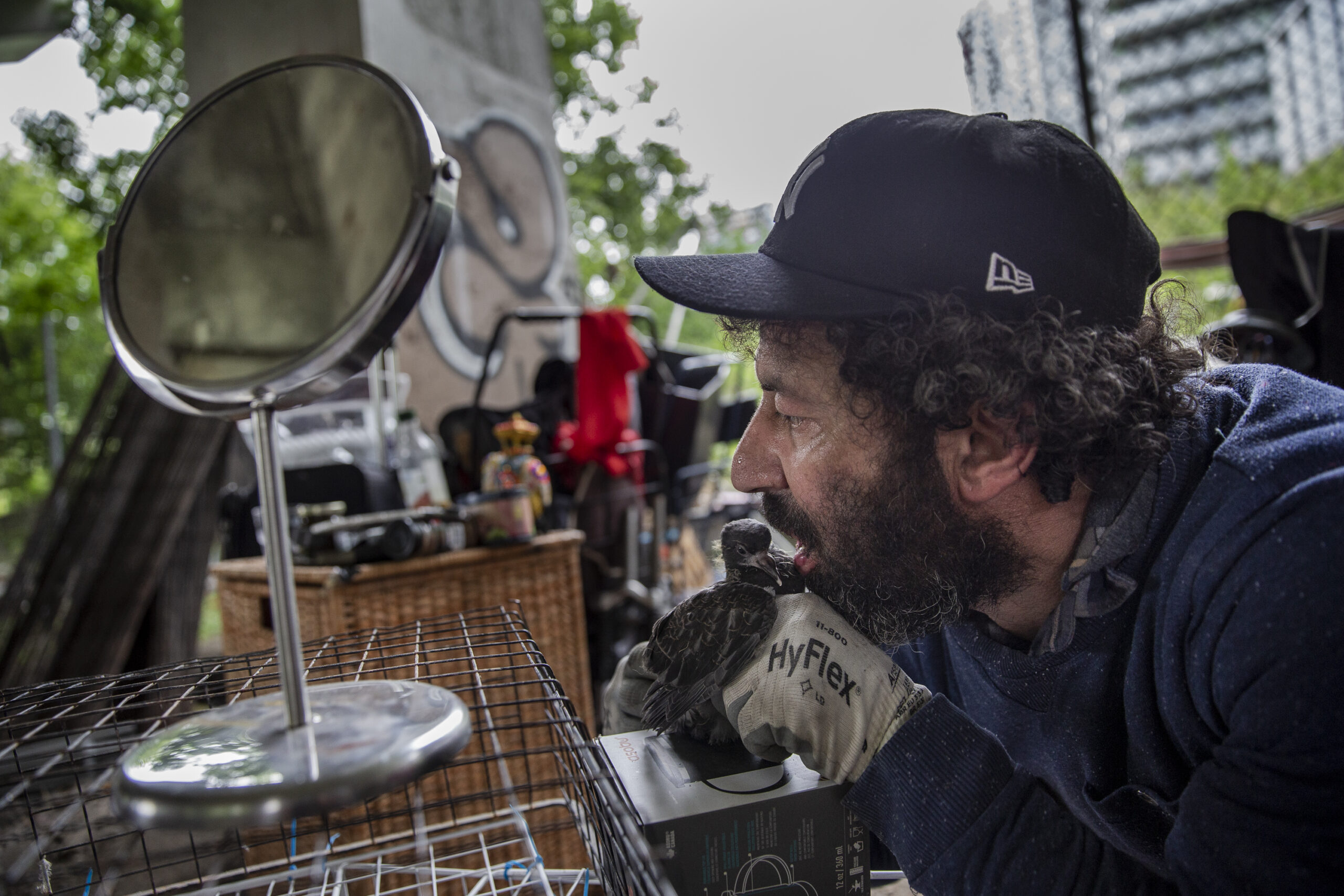
Sesisheili’s movements have followed the ebb and flow of the city’s unhoused population, through the downtown parks and encampments that grow until they’re quashed by police, city staff, and private security. Since 2020, Kozak has photographed him, as well as other homeless residents of the city—familiar faces that came and went at these parks, men who gave their names as Kenny, J the Letter, Nuno, Matteo, “I Swim”, and Clancy.
This summer, Kozak and I spent months getting to know the people living in Clarence Square Park. We pored over comprehensive new data obtained from the City on the population changes of Toronto’s biggest encampments. And we spoke with encampment residents from across the city, to try to understand how homelessness has changed over the past five years in Canada’s biggest city, and how it hasn’t.
Today, encampments are a fixture of Toronto, as familiar as the cherry-red 501 Queen streetcar, or the city’s legions of raccoons. The City has largely stepped away from dispatching waves of police officers and private security guards to violently clear encampments like those at Clarence Square Park. Instead, they’ve promised enhanced outreach to bigger camps: robust mental health supports, food deliveries, harm reduction supplies, cleaning crews, better security, and a shot at independent housing.
Spend enough time at Clarence Square Park, and it quickly becomes obvious how little has changed since the City’s supposed “action plan” took effect. By and large, when they’re willing to go, encampment residents are moved into shelters, with little chance of landing a permanent home. Smaller encampments, spreading further into the city’s uncramped inner suburbs, are quickly cleared by security before they get a chance to grow.
Handing out sandwiches and clean needles is certainly better than nothing, but most unhoused people will tell you they need a home of their own, and many residents at Clarence Square Park have waited a while—or simply don’t trust the options they’ve been given. It isn’t hard to see why encampment residents, living the worst days of their lives, might suddenly lash out in public. “When you’re in the swamp,” Sesisheili tells us, “it’s hard to get out.”
In the winter of 2000, two unhoused men named Karl Schmidt and Tom Gold moved to an empty Home Depot lot to escape the living conditions of Toronto hostels. The strip of broken concrete and earth along the lakeshore, not far from the entrance to Cherry Beach, had been contaminated by heavy metals from decades of industrial use. The two of them lived in a plywood cabin with a kitchen and a living room. “I don’t like to declare myself homeless, because I built a house,” Schmidt said in a documentary at the time. “I have a home.”
This was an era not unlike our own. A time of high rents and a drug epidemic. Ontario’s premier was hell-bent on cutting red tape. Dozens of Torontonians, unable to live in conventional housing, set up an encampment. Advocates, outreach workers, and a couple of supportive city councillors did what they could. A local architect designed modular prefabricated houses for residents. But Tent City was gone three years later, evicted by police from the Home Depot lot in 2003.
The people who were trying to fix this problem as activists years ago are still struggling to do so today. The architect, John van Nostrand, is now the senior director of Two Steps Home, a nonprofit focused on building “cabin communities” in Toronto to end homelessness. Cathy Crowe, a longtime street nurse who campaigned at Tent City, is into her third decade of advocating for homeless Torontonians. One of the two supportive councillors was Olivia Chow, who now, as mayor, oversees a city overwhelmed by homelessness. People have always lived in tents, under bridges, and in ravines in Toronto. For many years, a favoured spot for unhoused Torontonians was in the bush along Rosedale Valley Road, where “you’re less likely to get cleared,” says Sanctuary Toronto outreach worker Greg Cook. Over the course of a few hours, Cook and I inched our way up and down the steep ravine on paths carved into the brush by habitual visitors, a quick hike from Bloor Street East and, from there, the downtown core. We find signs of life under the buttresses of the Bloor Viaduct: discarded beer cans, cardboard, blackened ground where fires once burned.
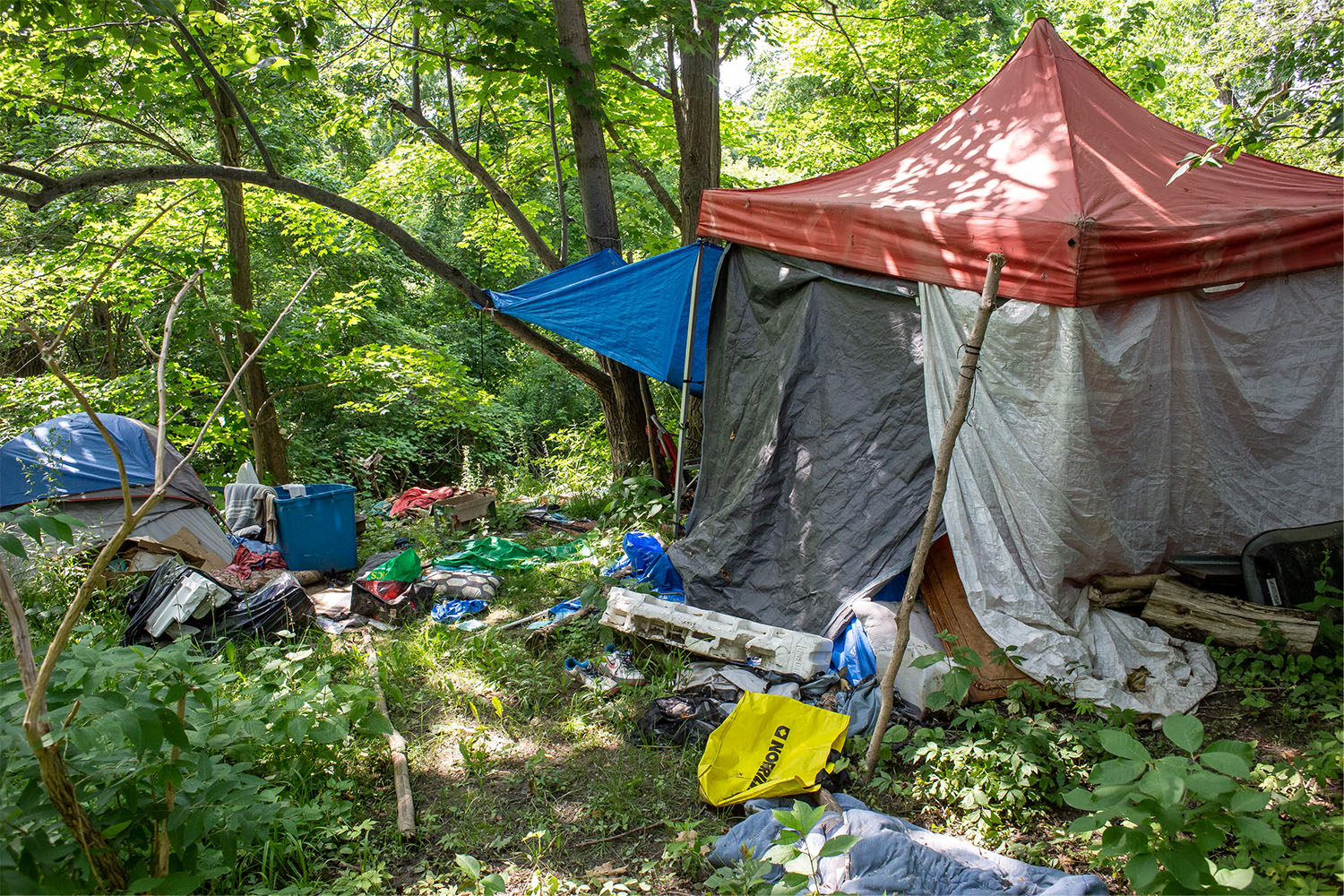
In the years before the COVID-19 pandemic, city workers routinely kicked unhoused people out of these spots. In 2019 alone, Cook tells me, the City said it conducted roughly 700 evictions—the highest in a decade. The rise of Toronto’s unhoused population is the result of a multitude of factors all converging at once: an ongoing rise in housing prices, drop in social assistance rates, underfunded mental health care, and drug toxicity. Then the COVID-19 pandemic struck, and people lost their jobs, many of whom were already living hand to mouth. By June 2020, the number of first-timers in the shelter system started to increase. Once it started, it didn’t stop. Within a four-month period from July to October 2021, the number of first-time shelter users in Toronto nearly doubled to around 6,700. And despite the efforts of staff, more than 1,300 people contracted COVID-19 in Toronto shelters during the first two waves of the pandemic.
Five years ago, it was rare to see an encampment out in the open. But COVID-19 left many unhoused Torontonians—some relatively new to homelessness, others living on the streets for years—feeling like there was no better way to survive than pitching a tent in a public park. In the years since, with the city reeling under the dual crises of unaffordable housing and unregulated drugs, more and more Torontonians have ended up on the street. In 2023, after years of work by the City, just under 6,000 people were successfully moved to permanent housing, according to a City of Toronto report. That same year, over 10,100 Torontonians became homeless for the very first time. For those already living in encampments—some unknown portion of the 12,000 estimated Torontonians with no fixed address—the past few years have been spent surviving as best they can through heat waves, flash storms, evictions, and a global pandemic.
Local Journalism Matters.
We're able to produce impactful, award-winning journalism thanks to the generous support of readers. By supporting The Local, you're contributing to a new kind of journalism—in-depth, non-profit, from corners of Toronto too often overlooked.
SupportAt the start of 2021, Toronto was hosting some of the largest encampments in the city’s recent history. Data obtained by The Local from the City, in part through Freedom of Information request, reveals the scale of the crisis. The City doesn’t comprehensively record the average number of tents or people in every park per week or month, they told us. It’s difficult to keep track of everyone across Toronto’s 1,500 or so parks and greenspaces. Instead, the City was able to provide the average number of tents per month for the top 25 most populous parks, from January 2021 to August 2024.
What is clear is that Toronto’s homelessness problem isn’t getting any better. “Cities across Canada are experiencing rising numbers of encampments due to insufficient income supports, unaffordable housing, ongoing shelter capacity pressures and social crises like mental health and drug toxicity,” says Gord Tanner, general manager of Toronto Shelter and Support Services, in a statement.
The City was starting to panic.
Crackdowns on encampment residents had been happening from the very beginning, with city bulldozers mowing down tents, and residents receiving trespass notices and risking tens of thousands of dollars in fines. Sesisheili was kicked out of Trinity Bellwoods and Lamport Stadium. But the most violent clearings conducted by the City took place in a single week in June 2021. Hundreds of City-hired security guards and police officers, some with riot control gear, effectively laid siege to these encampments, hemming in two dozen residents and scores of protestors between city fencing. The events that transpired, broadcast live on TV to horrified city residents, haunts the City of Toronto’s encampment response to this day. The resulting displacement of unhoused people in the city is apparent in the data.
It’s hard to know where encampment residents displaced in the raids ended up. The City claimed it gave them plenty of warning, and offered them spots in shelters or at hotels, but few residents at Trinity Bellwoods or Lamport Stadium seemed inclined to take them. Some moved to different encampments. And because the City counts tents, rather than individuals, it’s possible some people bunked with others, like Sesisheili frequently does, or found other temporary accommodations. Researchers at Osgoode Hall Law School found very few encampment residents got the permanent housing they were promised. “Most simply relocated elsewhere outdoors,” read a December 2021 report by the school’s Environmental Justice and Sustainability Clinic.
For its part, the City claims it doesn’t demolish encampments any longer, but provided a link in its statement to its Interdivisional Protocol for Encampments in Toronto, which includes steps on how to enforce trespass notices. This includes the demolition of structures present at an encampment. “This action begins only in cases where there is an immediate public health or safety risk to people in the encampment or the surrounding communities; or after extensive support efforts have been unsuccessful and an individual continues to decline referrals to shelter space or meaningful work on a housing plan,” the City said in its statement.
The number of people encamped in city parks has grown in the last year. Data from March of this year revealed there were more than 200 tents across 72 parks at the time, compared to 82 tents across 24 parks the same time last year. But the large-scale encampments seen in the summer of 2021 are largely gone. In their place, smaller encampments are slowly growing in number. Many are popping up farther from the downtown core. Ravines, parks, and community centre properties across Toronto’s suburbs are increasingly host to residents unable to live anywhere else. Others are used by people who have truly nothing: not a home, not a tent, not even a sleeping bag.
Nestled into a leafy postwar suburb in North York, Goulding Park is an odd place to find an encampment. Just to the north is Centerpoint Mall, a major shopping centre near Yonge Street and Steeles Avenue. Yet sure enough, when we drive through the deserted suburban streets on a scorching hot mid-June day, Nick Kozak and I find two crude shelters, including one propped up against the wall of the park’s community centre. No one is home. As we walk along the park’s length, we notice, beyond the tennis courts, a small crowd clustered around a charcoal barbeque.
Encampments were once considered a downtown phenomenon, but that’s no longer the case. In 2021, just two of the top 25 biggest encampments—at Caledonia Park and G. Ross Lord Park—were found north of Bloor Street, west of the Humber River, or east of the Don Valley. By 2024, at least eight encampments met this criteria. East Highland Creek Watercourse, in Scarborough, was one of the city’s most populous encampments this spring. From January through August 2024, the most recent data provided to The Local, the City’s list of most significant encampments included Crawford Jones Memorial, Downsview, and Earl Bales Parks, all locations in North York.
Goulding Park, as it turns out, also hosts a few regulars who don’t have homes. There is Dmitri, a jovial and shirtless Ukrainian. Charlie, a tall Jamaican man in a blue smock, grills up lunch on a barbeque. A short, muscular man with long black hair in a ponytail staggers around, shockingly drunk, at one point asking me in a very soft voice to go with him to the LCBO. Eugene, a broad-chested white man in a polo shirt who helps Charlie and the others cook, is one of the two tent residents. He’s lived at the park since May. Nearly every good day in the summer, people like Dmitri and Charlie and Eugene hang out to drink, eat, and relax during the day, then go their separate ways for the night.
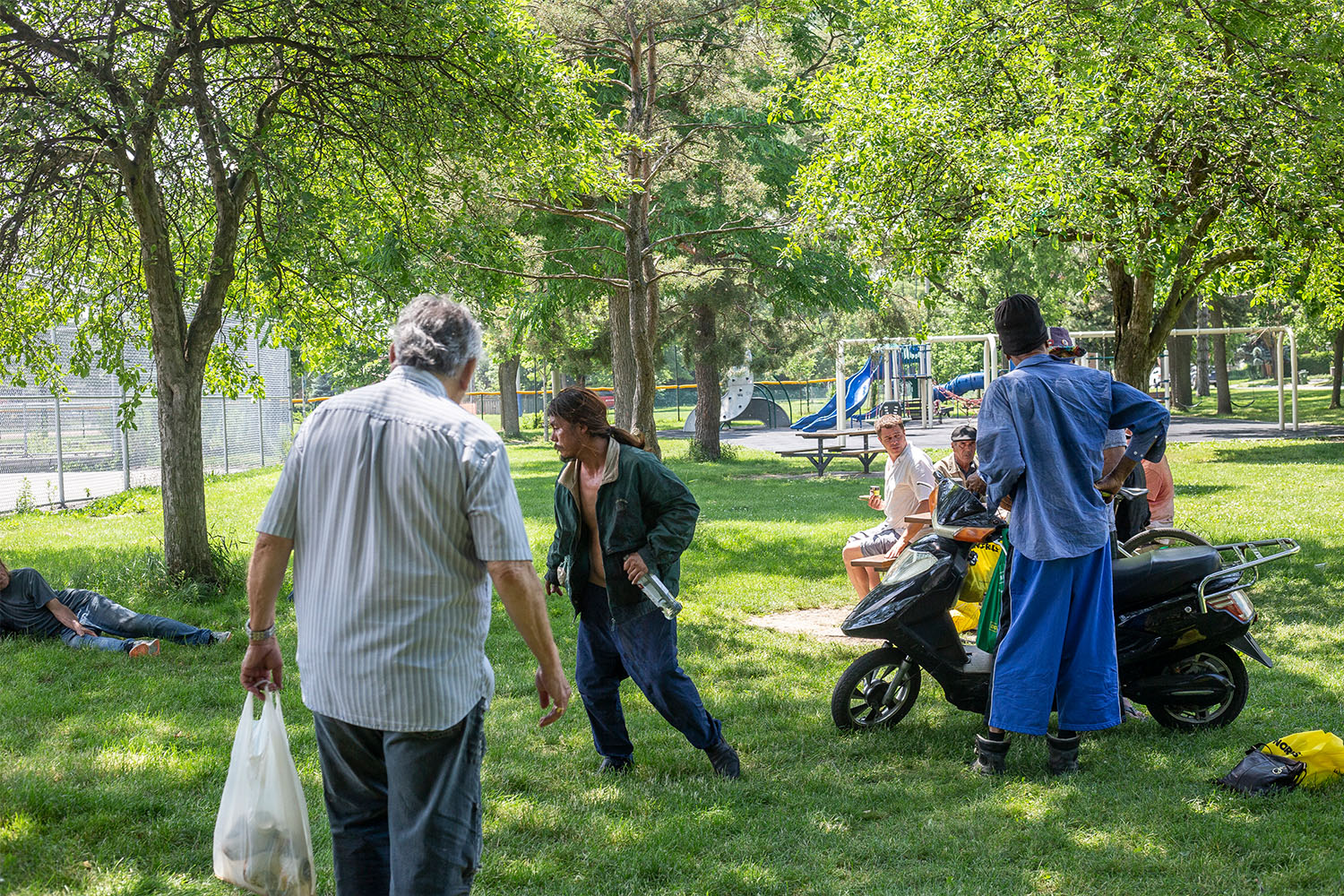
This crowd is completely different from the downtown encampments I’ve seen. While a few, like Eugene, don’t have a place to sleep at night, many of them do. Charlie says he lives with his mother; I later find out from Vicky Sanderson, a drop-in volunteer in the area, that many of the people here live in public housing and hang out at the park during the summer to cool off.
Many of them also have close ties to the area. One man, a weathered 63-year-old landscaper whom I’ll call Mark (a pseudonym, to protect his privacy), grew up in the Yonge and Steeles neighbourhood. Mark lost his last address, a nearby basement apartment, after his landlord kicked him out for drinking too much. And Mark does drink heavily. He tells us he goes through a 26-ounce bottle of vodka a day, although he’s looking to quit drinking the same way he quit crack cocaine nearly 15 years ago. He swings intermittently between irritation and a weathered gentleness when we talk, and I don’t think Kozak or I ever see him fully sober. Since the spring of 2024, Mark has lived behind a car wash, on a pallet.
In the mornings, he picks up his dog from his old address, where a friend of his still lives, and goes for a walk. Then he wanders over to Goulding Park to drink and spend time with his friends. Mark won’t go to a shelter, and has no interest in moving to a downtown encampment. Yonge and Steeles is his neighbourhood, and he knows people up here. “I know people that own restaurants,” Mark tells us, wearily lying on his side at Goulding Park. “I can get a pizza anytime I want.” But the last time we see him, he tells us he’s working with a caseworker to secure housing.
In some ways, living unhoused in some unseen corner of North York is harsher than a downtown encampment. While there are drop-in centres and food banks, there are far fewer places to crash at odd hours, like bank lobbies or subway stations. Mark has neither tent nor tarp. The night before our visit, Dmitri had stayed at the pallet with Mark, neither of them in possession of a sleeping bag. Kozak and I checked it out. All that spared them from the elements is the car wash’s wall and some nearby foliage.
Vicky Sanderson started noticing piles of clothing and food containers at Goulding Park back in 2015, when she lived nearby. “It wasn’t long before I realized—oh man, there are people living at the park,” the volunteer tells me at a drop-in lunch in the lower hall of Cummer Avenue United Church.
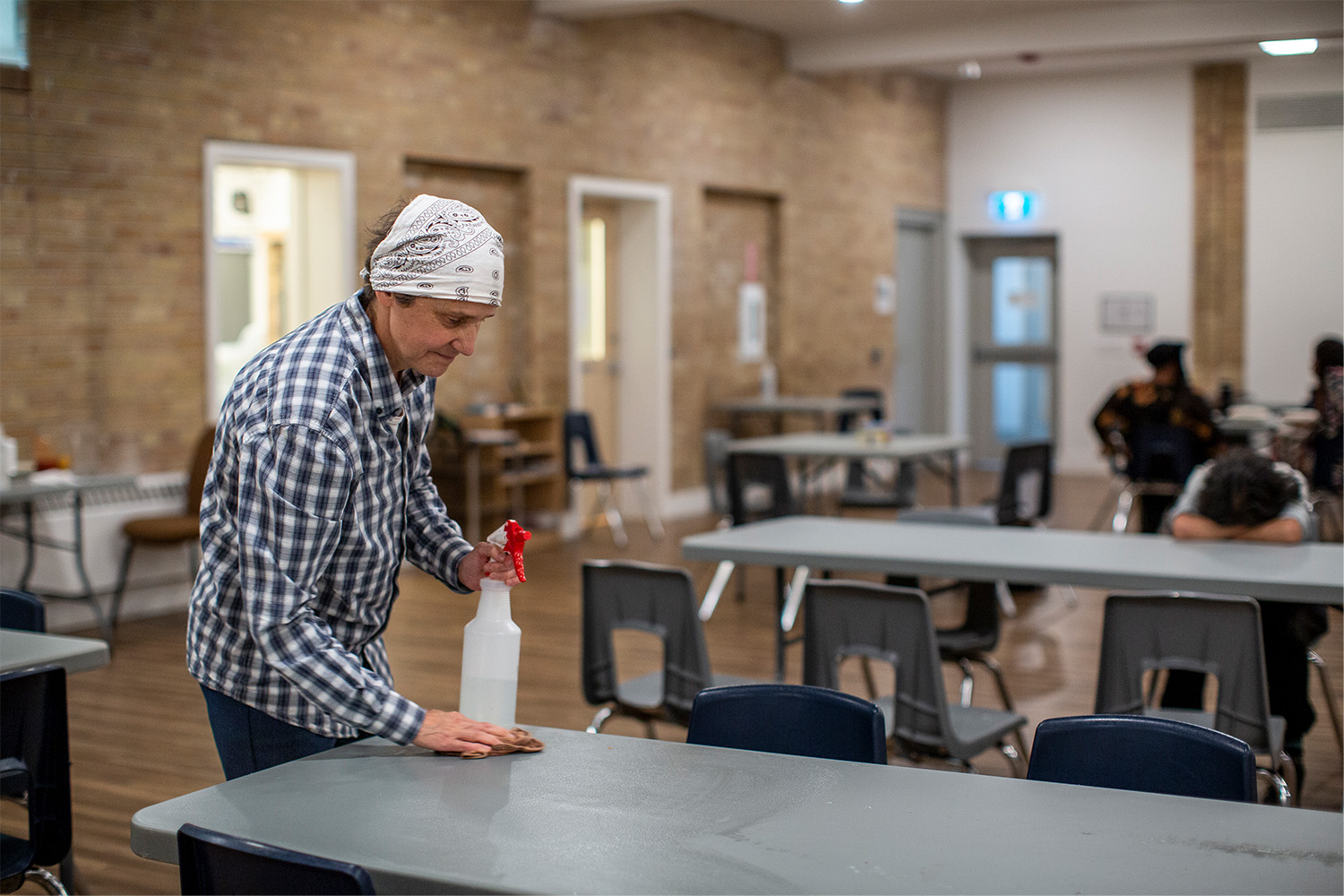
Back in 2015, Sanderson says, she was constantly bugging the constituency assistant of then-councillor John Filion about services for unhoused Torontonians in her ward. In short, he told her, there was nothing. The same is true today. Sanderson says the urgency of the situation hasn’t really landed with Councillor Lily Cheng, who currently oversees the local ward, and whom Sanderson describes as taking a law-and-order, “church charity” approach to homelessness. During Cheng’s campaign for ward councillor in 2022, she criticized the development of a local modular housing project that would house people currently residing in shelters and encampments. Last year, she introduced a failed motion at council to relocate the project elsewhere. In a statement to The Local, Cheng’s office emphasized the councillor’s commitment to listening to all sides of the issue. “Encampments are a growing concern across our city. This can be shocking for many community members for whom this has not been the norm…Our office tries to listen to residents’ concerns while learning about the needs of the unhoused from outreach workers to find a way forward,” the statement read.
“People are regularly sleeping outside,” Sanderson says. “There are folks whose teeth are falling apart.”
“There is just nothing here,” she says, “and the community response is that we’re not supposed to [have] poor people in Willowdale. They’re not supposed to be here.” She isn’t hyperbolic. Two days before Kozak and I visited Cummer Avenue United Church, city staff had evicted the encampment at Goulding Park. These smaller encampments are fairly discrete compared to places like Clarence Square Park. But when they are discovered, the City quickly stomps them out before they can grow.
Divided City
In Toronto, neighbourhoods separated by just a few TTC stops can be worlds apart in terms of how residents experience life, and death. Our latest issue is an unprecedented deep-dive into this city’s disparities—on everything from health and housing to who makes 3-1-1 complaints.
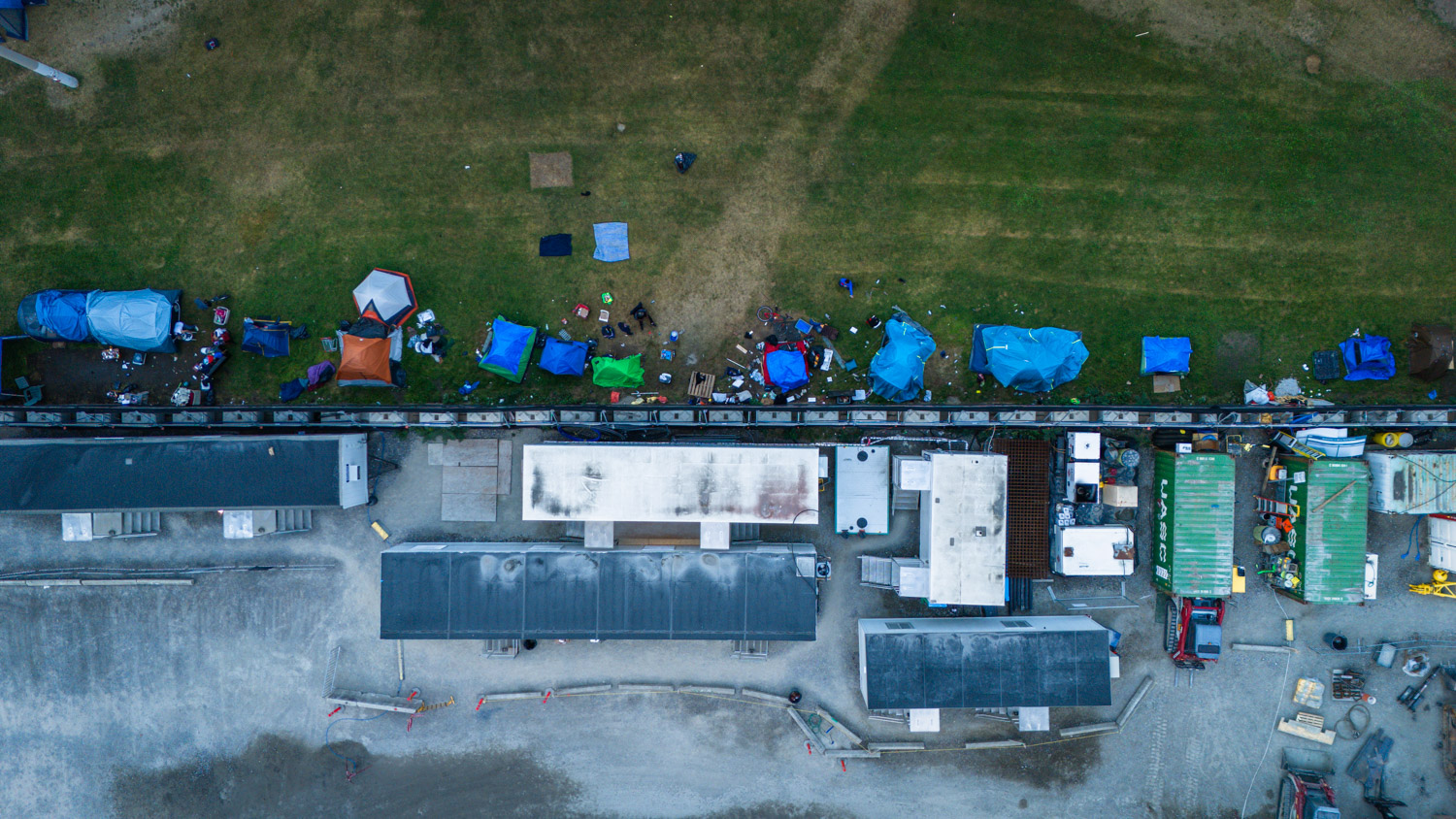
One sunny July morning this summer, I watch as city staff assemble to bulldoze a makeshift shelter at Marilyn Bell Park, on a strip of lakeshore greenery on the south end of Parkdale. One of its residents, Kal, a burly man with black hair, sits outside on the hut’s patio, surrounded by kitchenware, dazed. Just five days earlier, his partner Terra, who shared the shelter with Kal and a handful of others, had died.
On clear days, you could see the home built by Kal and a former roofer named Robert from the breakwater off the park shore. Terra had once swum out there to bask on the rocks, looking back at the tarp-clad, elongated hut made of two-by-fours and bound together with thousands of zip-ties. It had a kitchen, a bedroom, even a rooftop patio. It was where Terra had been in recovery. “I kept her clean for a whole year,” Kal tells me. “I just don’t know what happened.”
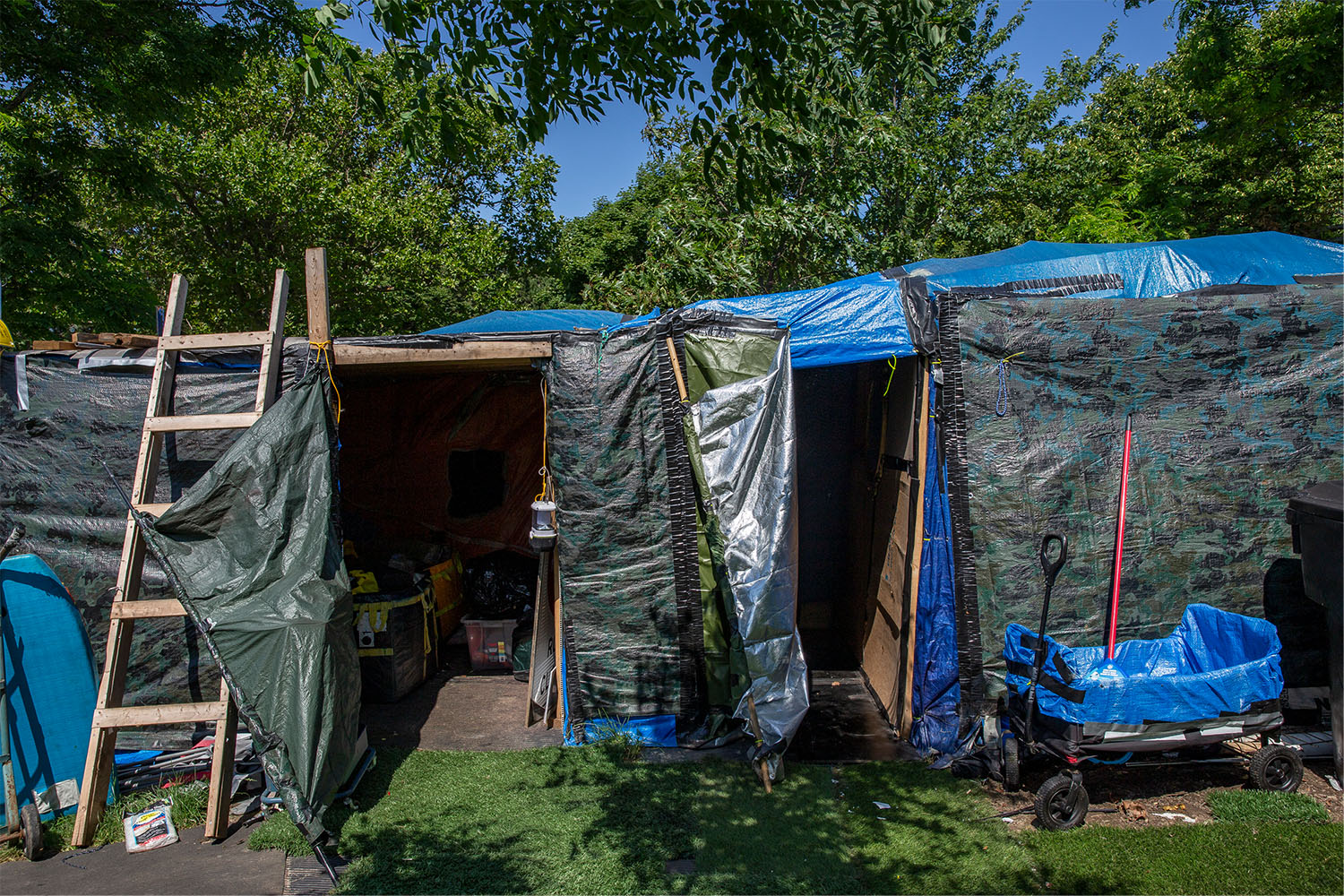
The enforcement of these one-off evictions is haphazard, seemingly subject to the mood of the enforcing officer and the force of the protestors that rally against them. Kal had received an earlier eviction notice last winter, but the City never bothered to enforce it.
On the morning the City planned to bulldoze Kal’s home, a group of grassroots encampment defenders, including members of a group called Voices for Unhoused Liberation, showed up to try and stop it. But Kal seemed resigned to the eviction. “I would fight for it,” he says of the shelter, “but I don’t want to be here anymore. It’s just too much.”
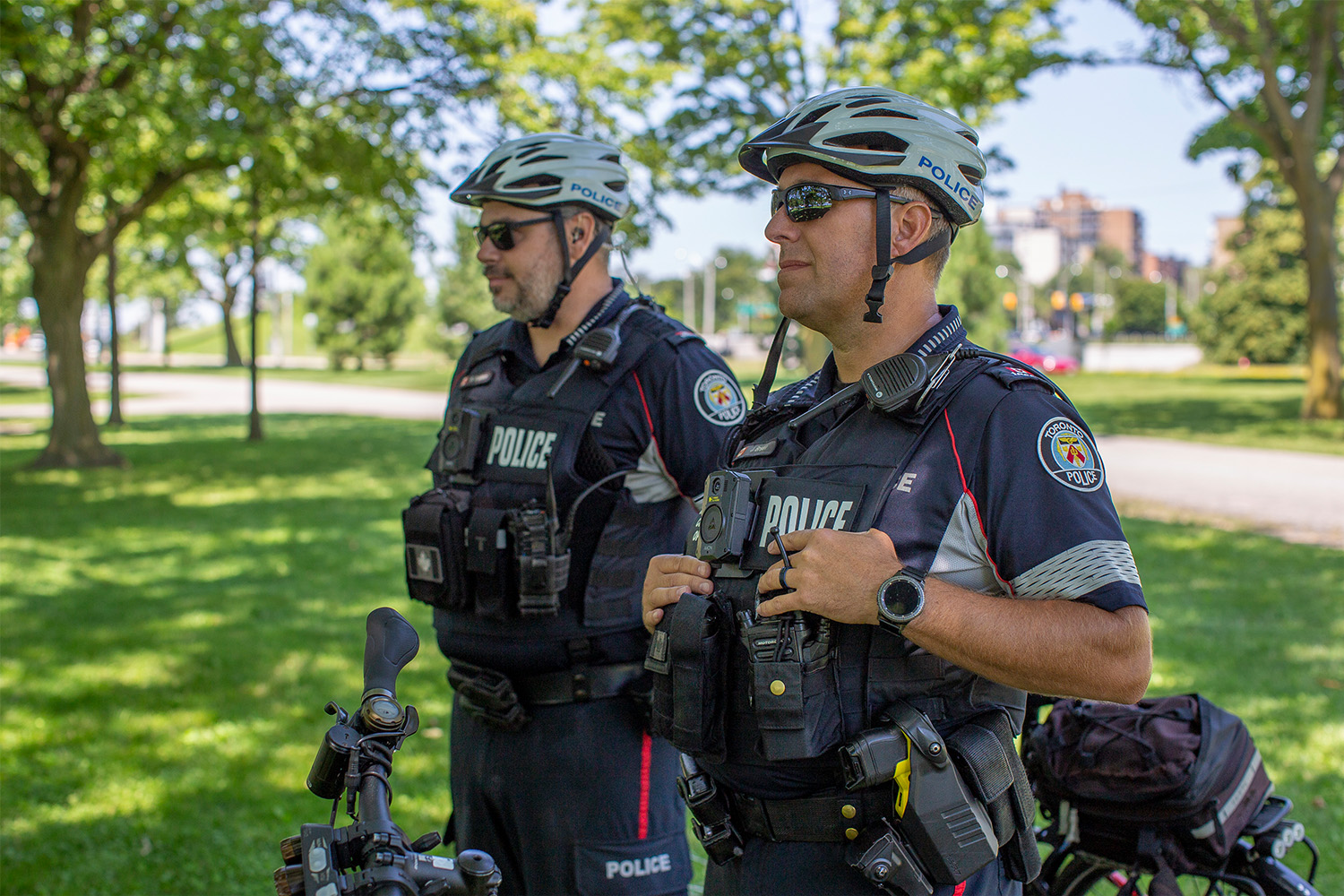
These evictions tend to go down in similar ways. First, says Voices member Natum Mann, workers with Toronto Shelter and Support Services will offer residents shelter spaces. Then, Parks and Recreation workers bring in dump trucks, and sometimes a heavy mover known as “the claw,” to destroy any shelters. The problem, in Mann’s eyes, is that the City doesn’t offer the residents any good options. “People might not realize they’re getting sent to a shelter in Etobicoke,” he tells me. “They’re getting sent to a shelter where they’re sleeping in a room with 30 or 40 other people. And they don’t have a choice.” Kal tells me he has a number of health problems, including diabetes, and uses a sleep apnea machine that isn’t easy to hook up in a shelter.
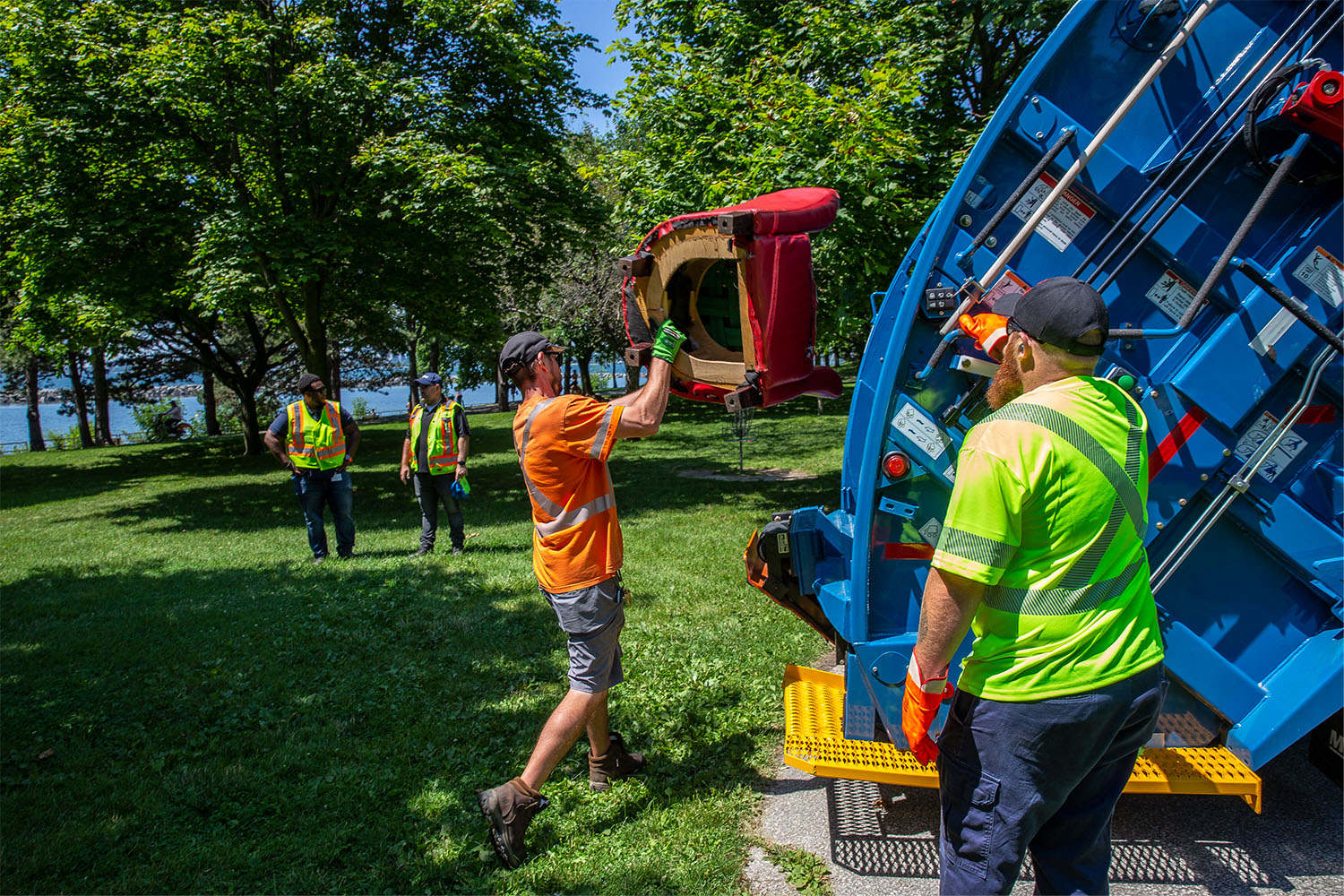
In the aftermath of the catastrophic summer 2021 encampment evictions, there’s a sense of spectacle attached to tent clearings, no matter how small. City workers muster around the perimeter near Kal’s shelter, while he chats with two bicycle-mounted police officers from the neighbourhood liaison unit, whom he seems to know. The advocates, many of them masked, linger around and wait for the inevitable. None of this was apparent to the cyclists racing along the Martin Goodman Trail in spandex bodysuits, talking about their jobs, seemingly ignorant of the eviction scheduled to happen.
Eventually, after hours on-site, and an unexpected, ugly disagreement between Kal and the advocates, the City decided to postpone its eviction. Kal was told he’d have another five days to leave. When Kozak returned to Marilyn Bell Park the following week, he found a patch of dirt with bulldozer tread marks and no sign of a tent. It had taken the City at least two visits from an enforcement officer, several hours on the clock by multiple city staff and neighbourhood cops, and the heavy machinery of trucks and bulldozers, to clear a home built from tarp, wood, and zip-ties. Someone had left a cross, presumably for Terra. We don’t know what happened to Kal, or where he went.
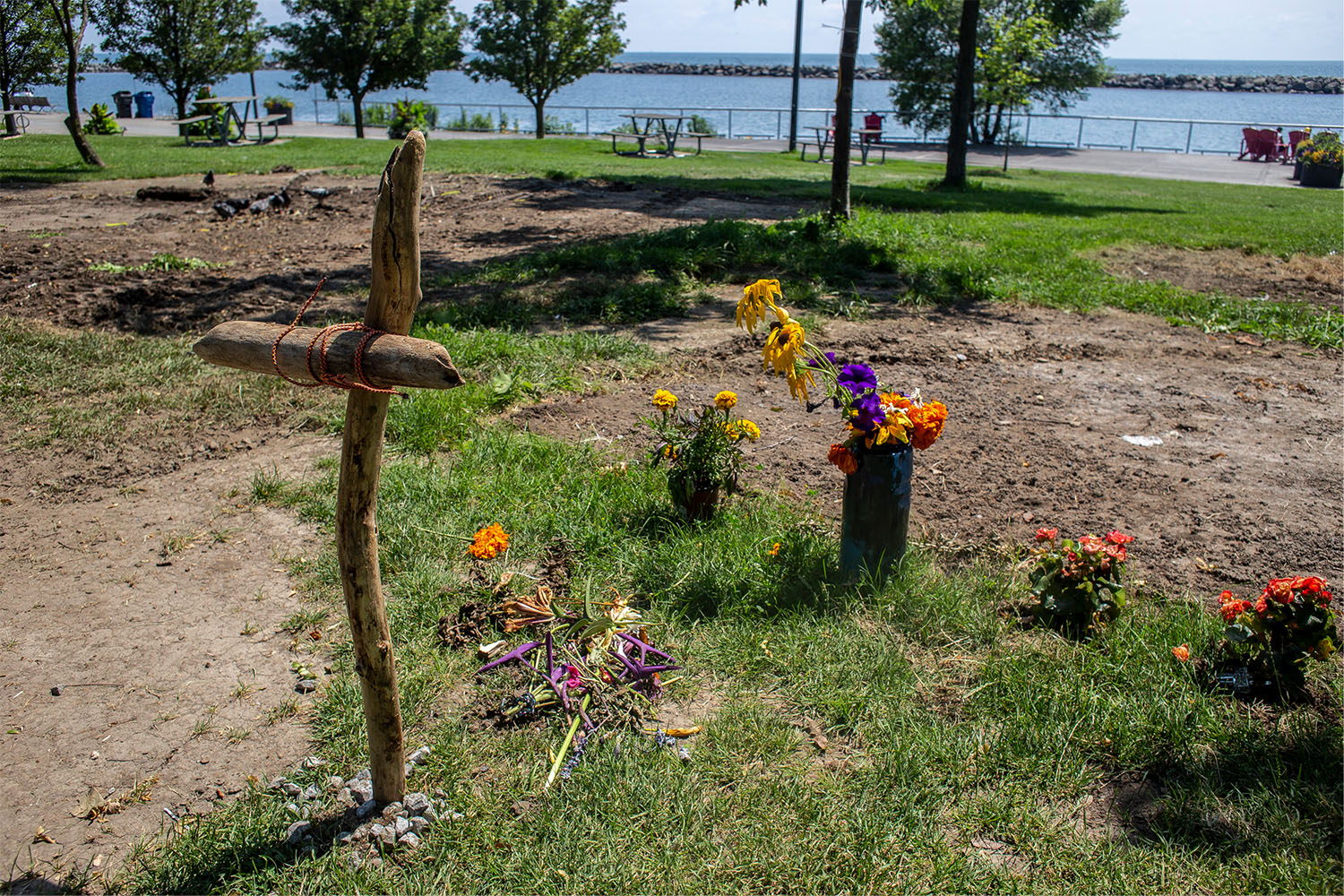
Every week, new residents show up to Clarence Square Park and other encampments across the city. When I meet Nate, a baby-faced 32-year-old who used to work as a delivery driver for Amsterdam Brewery, he’s only a week and a half into his stay at Clarence Square, and only a few weeks into being “on the road” at all. His former landlord didn’t let him renew his lease, and the Landlord Tenant Board doesn’t hold hearings quickly. “I was like—OK, I can do this for a month,” he tells Nick and I.
Reality quickly sunk in. He showed up at 129 Peter St., a drop-in site, and realized he wouldn’t get a bed anytime soon. A local told Nate he’d been calling for a shelter spot for a week straight with no luck. “There aren’t as many beds available as people think,” Nate says. Throughout the summer, shelter intake staff have had to turn away more than 230 callers a night, on average. The shelter at 565 Lake Shore Blvd. W. wasn’t an option. Eventually, he heard about the Clarence Square Park encampment, and moved his belongings with a two-wheeled foldable shopping cart. He now sleeps in a tiny one-person tent on the perimeter of the encampment. “I feel fortunate because, honestly, I had nowhere else to go. No respect. Nothing.”
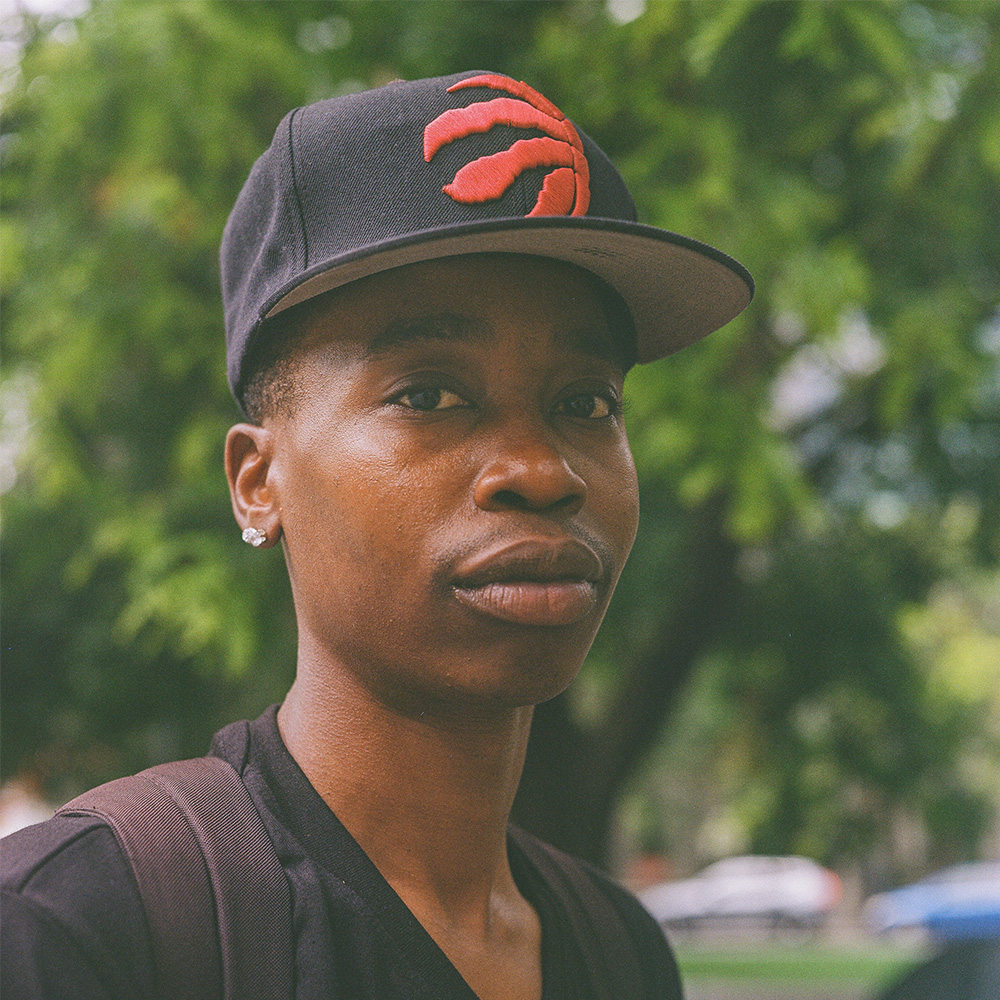
When a newcomer arrives at Clarence Square Park, someone has to vouch for them. For Nate, it was Michelle, a 28-year-old English literature major who can often be found browsing the Indigo at The Well, clad in a Patagonia jacket and leggings. At first sight, she doesn’t look unhoused. But she’s lived at Clarence Square Park for about eight months, and has been without a home since the fall of 2020. She knows what it’s like to use drugs, specifically methamphetamine and alcohol, and to lose an apartment in Little Italy during a split with an abusive boyfriend because she couldn’t afford it. Now, to the camp, Michelle acts as a combination of organizer, den mother, and advocate. But some days, I notice her nod off mid-conversation. The first time I see it, I ask Michelle if she’s OK. She tells me she hasn’t slept in three days.
Encampments are as much a health problem as they are a housing problem. In 2021, the last time the City of Toronto conducted its Street Needs Assessment—a survey of unhoused people, including encampment residents—roughly half said they had mental health issues like depression or PTSD. Just over 40 percent admitted having a substance use issue. A third had some kind of illness, including diabetes and HIV, and a fifth cited cognitive conditions like ADHD, autism, or a traumatic brain injury. Most are dealing with at least two of these conditions at once.
Two of the residents I’m introduced to at Clarence Square Park are dealing with meth-induced psychosis, friendly but prone to conversations that are impossible to follow. To Michelle, these problems are why encampments exist in the first place. “This is never going to change,” she says, with Clarence Square Park’s muddy ground before us, “until we balance everything out.”
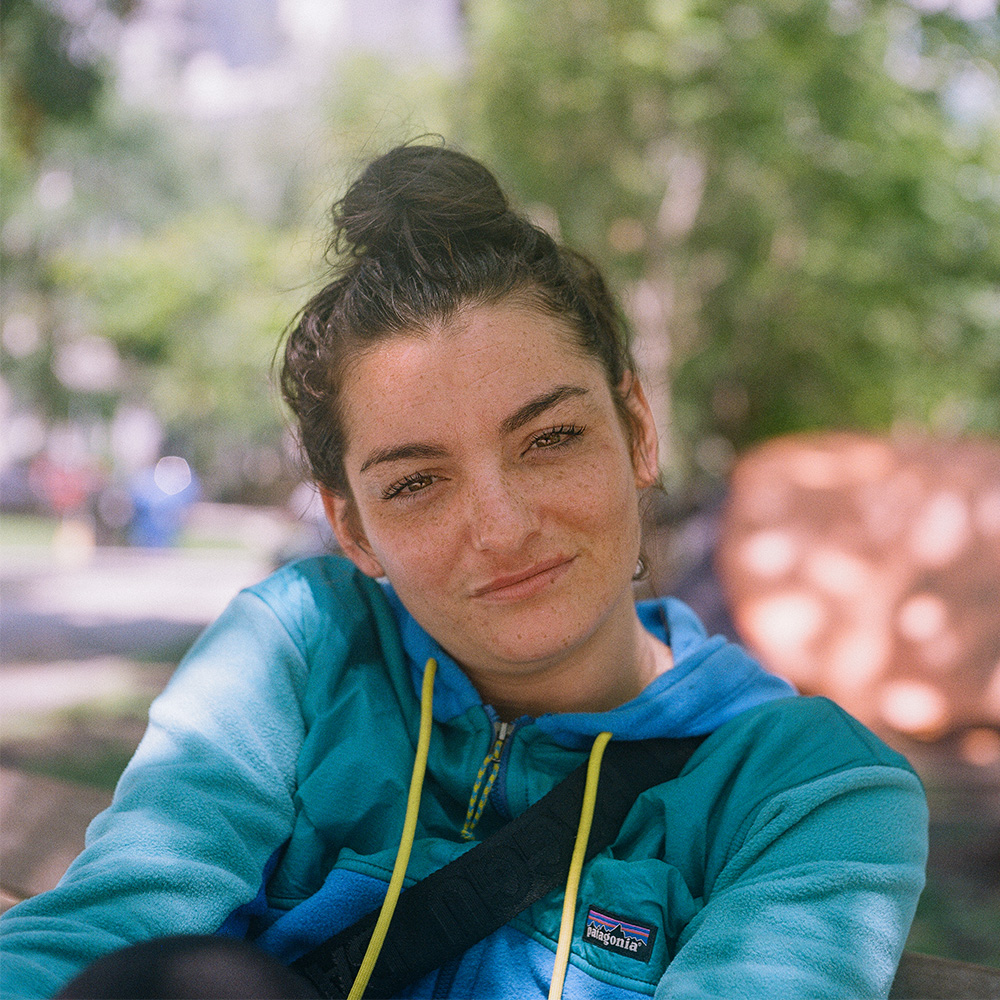
After the disastrous outcome of the encampment evictions in the summer of 2021, the City was forced to face the music. A scathing report published by Toronto Ombudsman Kwame Addo in 2023 condemned the decision to rapidly clear encampments as rushed and injurious, and as having created a widespread public perception that Toronto’s city government hated the homeless. Encampment defender Leon Emmedd, alongside many of the other activists we spoke to, pointedly blamed the “capitalist hellscape” for both the conditions of encampments and the city’s response to them.
Advocates saw the backlash as an opportunity, using Dufferin Grove Park, which had seen an eviction earlier that year, as a site to advocate for a new approach to encampments. Between August and December of 2021, in what became known as the Dufferin Grove Pilot Project, “They essentially let the encampment be,” explains Jesse Upton, an organizer with Encampment Support Network Parkdale. The City brought services like medical care, harm reduction, housing services, and even tax and ID clinics, into Dufferin Grove.
The project was ostensibly a success, with a reported 90 residents receiving shelter. But city workers also prevented new residents from moving in. And while the Dufferin Grove model seemed much more humane than clearing residents en-masse, in truth, only 26 of the encampment’s 90 residents actually received permanent housing, according to City data from March. The majority simply ended up in the shelter system, and around 15 residents left shelters for unknown locations. Some are believed to be back on the street.
Nonetheless, the project impressed policymakers, and City Council endorsed the Dufferin Grove model as a citywide strategy for encampments.
Clarence Square Park is one of the major encampments chosen to receive enhanced supports from the City through what ward Councillor Ausma Malik calls the Clarence Square Action Plan: daily clean-up crews from the City’s Parks & Recreation department, the “permanent ongoing presence” of Streets to Homes workers in the park, and additional security guards and fire safety personnel to guard against emergencies.
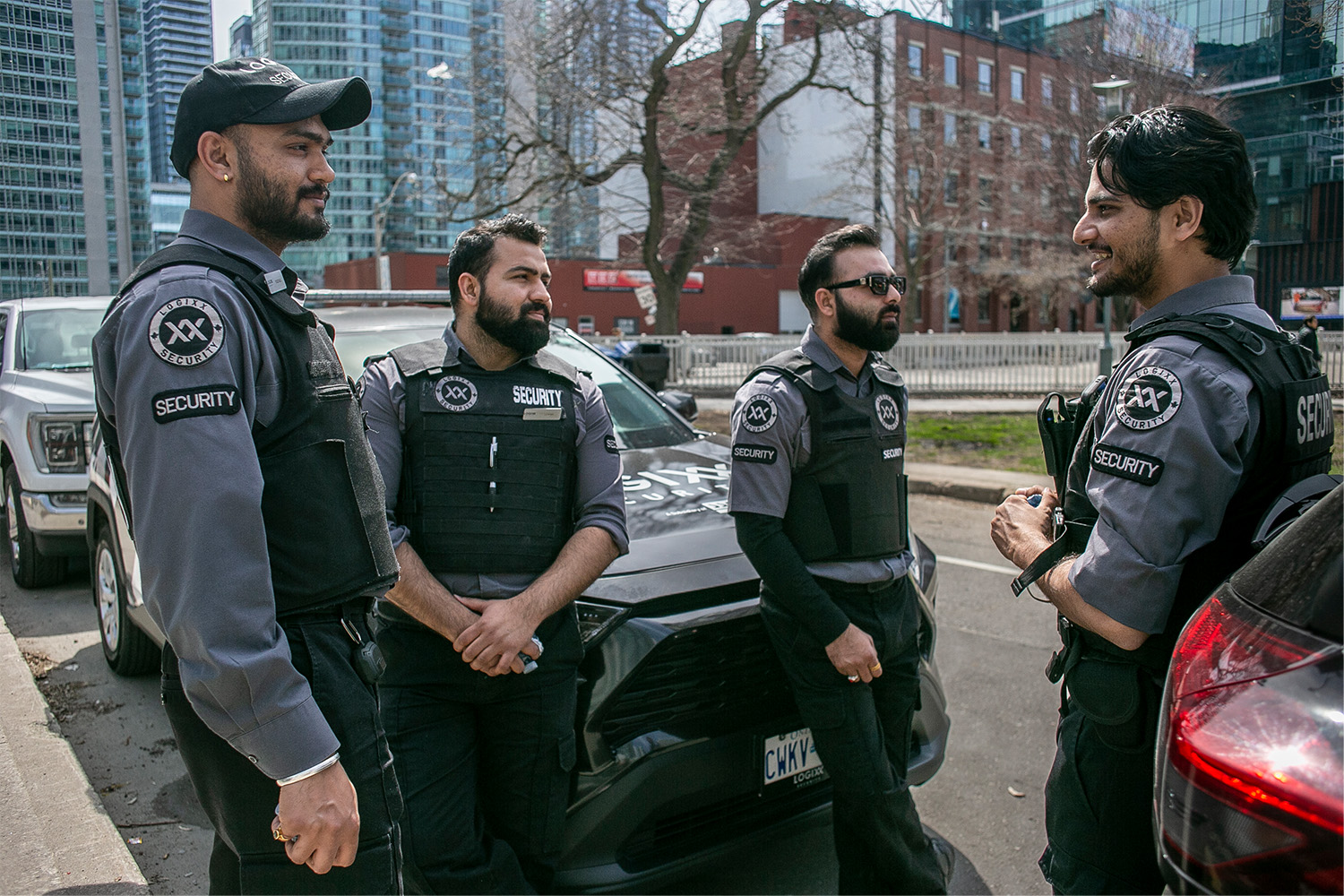
What this looks like in practice, most times that Nick Kozak and I visit, is two corporate security guards parked nearby, watching, or gazing at their phones or laptops in quiet moments. The Action Plan calls for regular clean-up by city workers, but occasionally, when Kozak and I visit, we see city workers in pickup trucks parked on the grass, simply staring out at the camp. Once, we see them do this for an hour. Encampment residents tell us they do most of the cleaning themselves. The two porta potties promised by the City for the residents also never materialize. Just one sits on the eastern edge of the camp, filthy and graffitied. (According to the City, the second one was ordered in the spring, but moved elsewhere. A replacement is supposed to arrive in November).
In late August, I dropped by the camp to see two new blue porta potties near Spadina Avenue—but even they weren’t part of the plan. As far as Sesisheili knows, they were installed by the City for drunk Jays fans. Both were padlocked shut on a Thursday afternoon.
The garbage, the wildlife, it’s getting to Nate. The stoicism he wore when we first arrived at camp has dropped away, replaced by jittery paranoia. He fears that trash is being left near his tent to mess with him. He gets wary around pigeons and squirrels. He hasn’t slept through the night in days, not even with Airpods and a beer or two, and it’s wearing him down. “There’s no winning for me out here,” he says.
Paramedics do drop in to Clarence Square Park for on-site checkups, as do outreach workers with sandwiches, water bottles, and harm reduction supplies like crack pipes and needles. Michelle tells us Streets to Homes workers show up, but just spend a few minutes at the site before moving on. The shipping container at the northeast corner of the park, ostensibly for use by outreach workers, rarely has anyone in it.
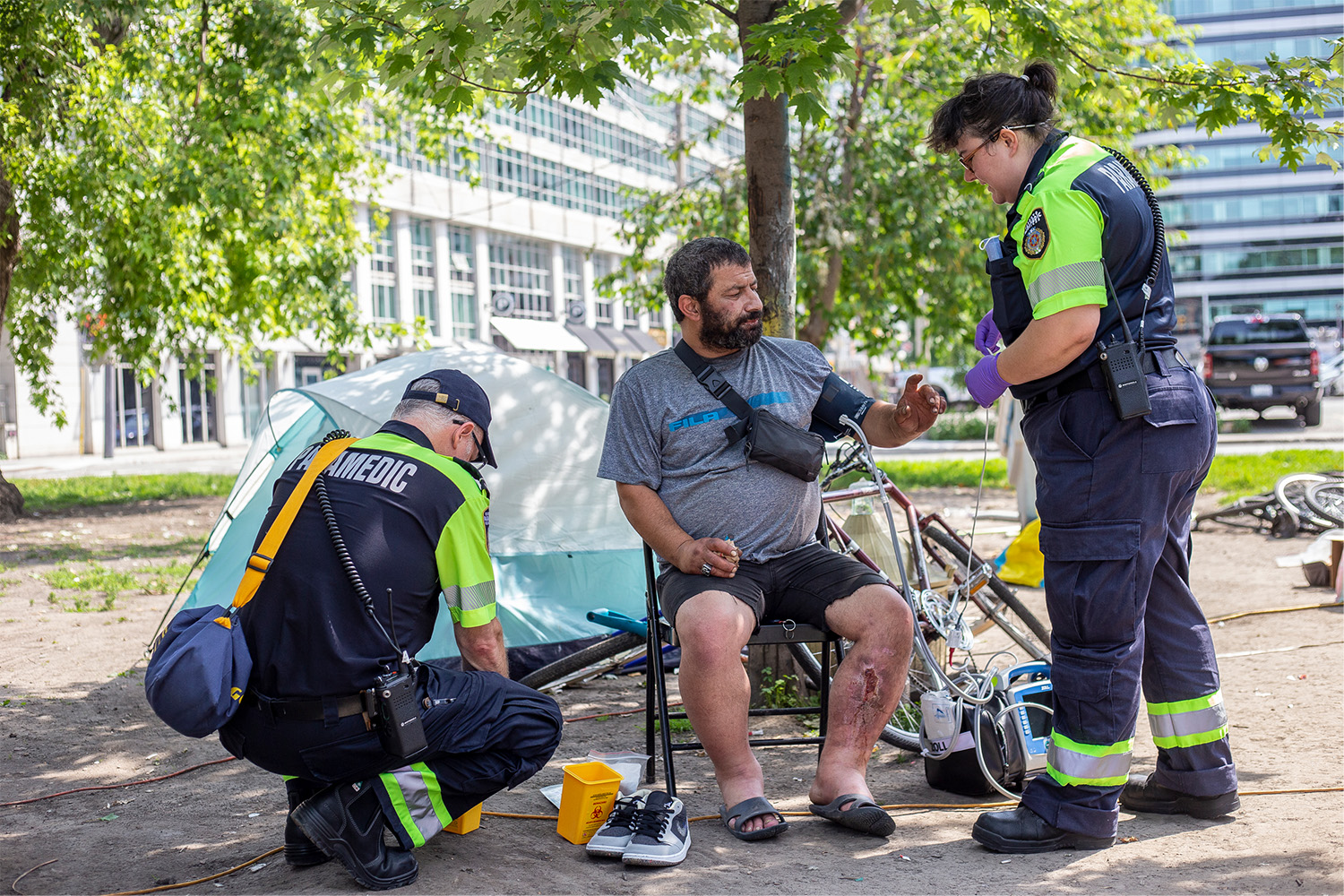
Michelle’s caseworker has told her she’s a priority case. Top of the list. “Two months later, where the fuck are you?” she tells us. She doesn’t even sound angry, just dismissive. “Not here.” According to the City, the average wait time for rent-geared-to-income housing for a “priority” applicant is four years. For anyone else who happens to be homeless, it’s closer to 14 years.
Councillor Malik refused an interview with The Local when approached. In a statement, her office said her efforts are slowly getting encampment residents the help they need. “This process takes time, given that shelters are at capacity and the long waitlists for affordable housing,” the statement read. “We are seeing important results, with 46 people having been referred indoors, and 10 of the 13 encampment residents currently working on a housing plan.”
The City of Toronto’s 24-Month Housing Recovery and Resilience Plan for 2023 and 2024 is supposed to create 4,000 new affordable and supportive housing opportunities for Sesisheili, and Mark, and Kal, and Michelle, and Nate, and every other unhoused person we spoke to for this story. In fact, the City itself describes this urgent homebuilding initiative as Toronto’s leading path out of homelessness. Mayor Olivia Chow’s background is seemingly perfect for resolving encampments, with her advocacy all the way back to Tent City.
But none of this is enough. According to documents from earlier this summer, the City has already managed to provide affordable housing benefits to roughly 3,300 Toronto households. But it depends on funding from both the province and the federal government to hit its 4,000-unit target, and it is already short. “Presently, there are almost 93,000 households on the City’s Centralized Waitlist for social housing and more than 12,100 people are being supported in the City’s emergency accommodations and shelters,” the City said in its statement to The Local. “However, on average, only 3,000 RGI units become available each year, illustrating the disparity between the growing need for subsidized housing and the lack of supply.”
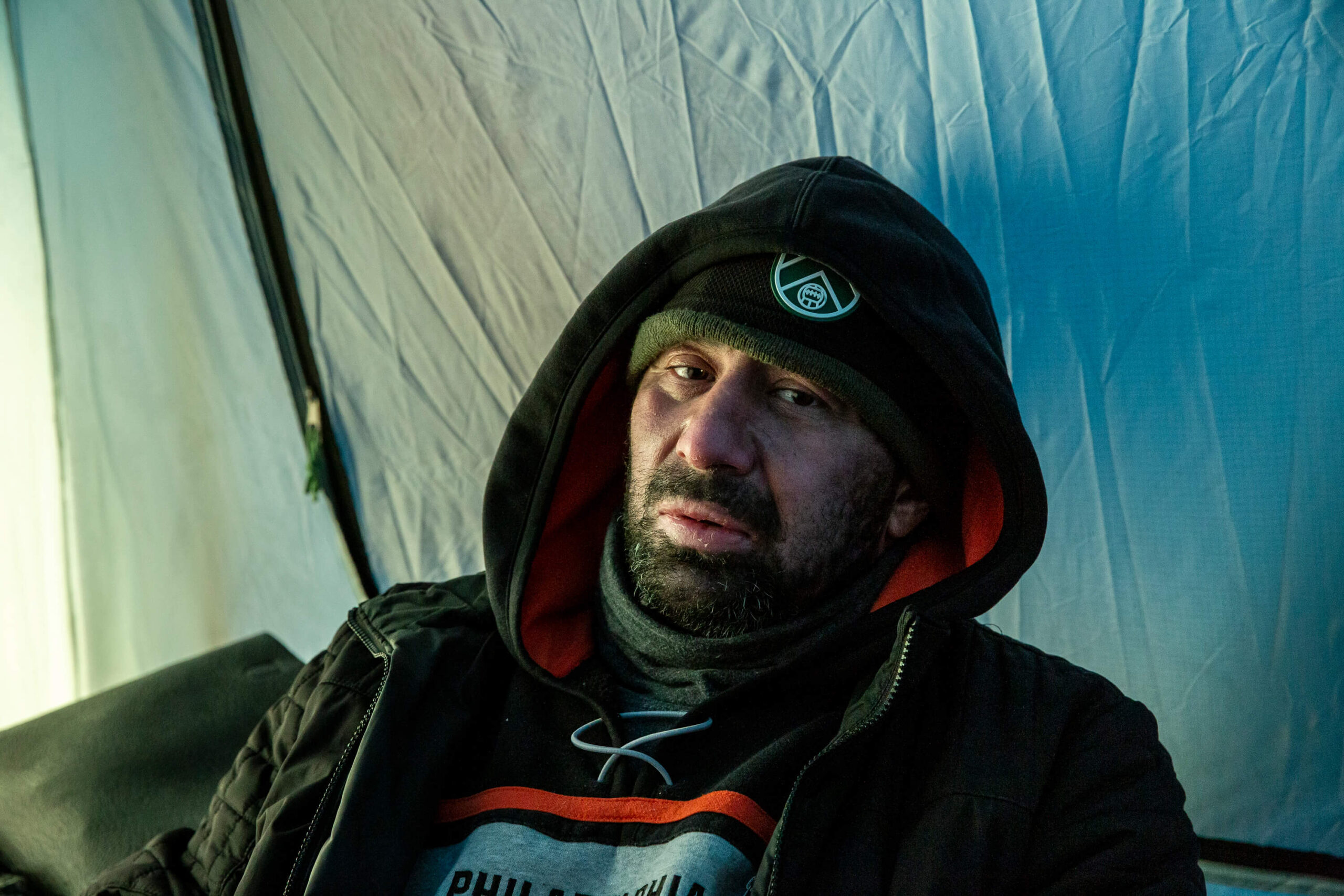
One Saturday in late July, as I cycled along Bloor Street, alarm bells went off in my head. I was downtown for a visit to a bookstore, but something Kozak had recently told me was bouncing around my head. When he’d visited Clarence Square Park the week prior, Sesisheili asked for Kozak’s phone number, and said he was getting a low-cost cell phone plan available to low-income people. That suggested he expected to be kicked out of the park somehow. I was in the area. I had to check in on him.
Never before in my career have I experienced such a sense of responsibility to the sources I’ve interviewed for a story. Every time it rains, I think about Michelle and Sesisheili and Mark—and others not named in this story, Kimberley and Tsunami and more—who live outdoors. I am also deeply embarrassed. Not four kilometres from the largest encampment in Toronto, behind my modest one-bedroom apartment, my neighbours live in multimillion dollar mansions with enough equity to house anyone living outside many times over. I am doubtful that anything I’ve written here will meaningfully change the circumstances of those who welcomed Kozak and me into their lives.
On that July afternoon, I did a slow circuit of Toronto’s largest encampment in the heat. Sesisheili’s massive shelter, the one I thought of as a workshop, was gone, its absence a gaping hole in the landscape of the encampment. I panicked and strode into the park. Sesisheili, thankfully, was there, in a T-shirt and sweatpants, and gave me his usual jovial hello. But then I noticed the bulldozer tread marks in the dry dirt. The City had given Sesisheili five days’ warning to clean up his tent and belongings, but he hadn’t moved. So they’d brought police officers and city workers early in the morning, and taken many of his belongings. “That’s when the City showed their true faces,” Sesisheili tells me.
Nearly three months later, in the first days of October, there was a fire at Clarence Square Park in the middle of the night, which residents and city staff told Kozak may have been set intentionally by a woman at the camp. In the morning, city crews came to clear away the burnt remains of a tent used as a hangout spot by encampment residents. When Kozak got to the park that day, one of the first cooler days of the fall, someone told him that Sesisheili had been given a trespass order by the City and was barred from the park. He was gone.
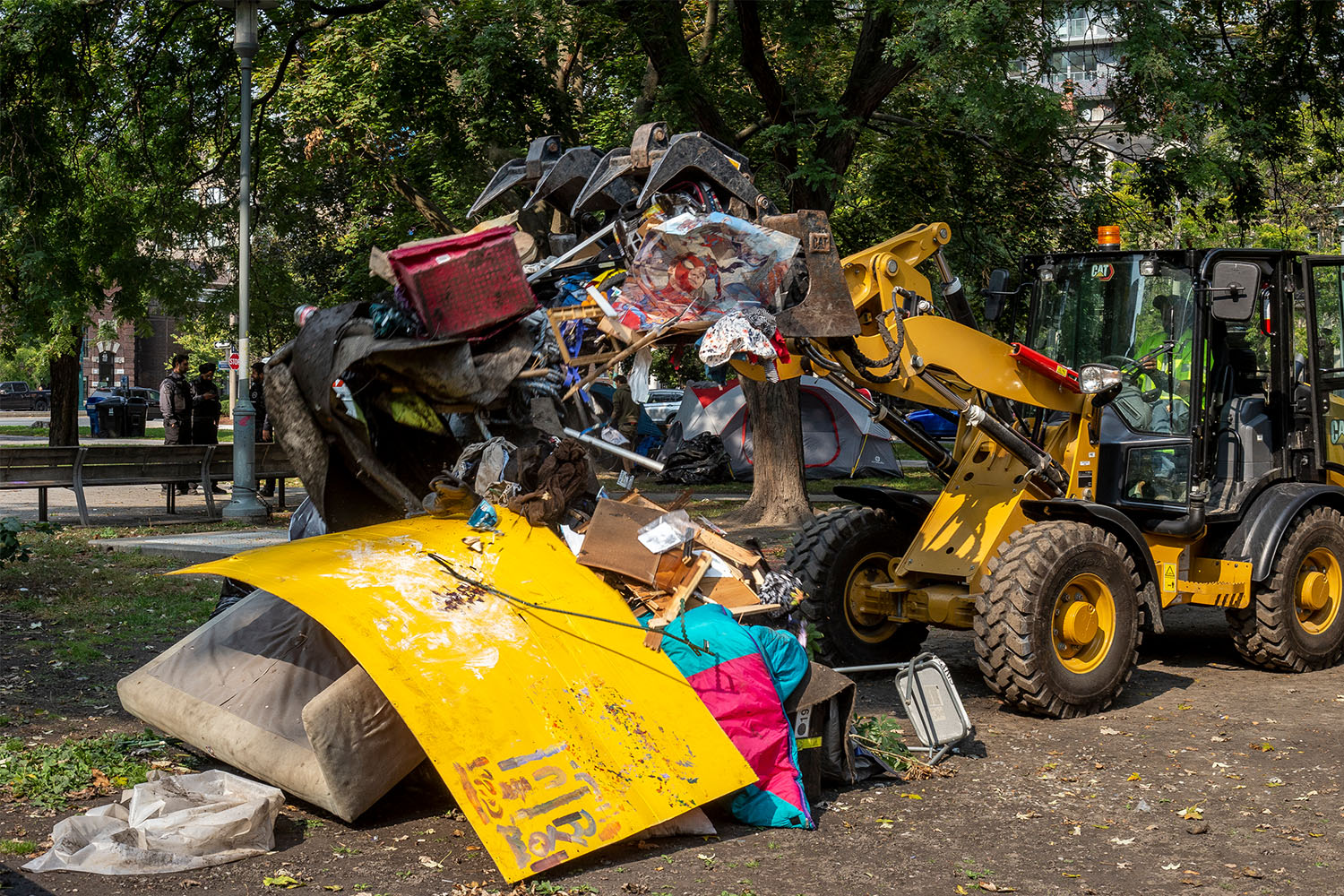
In the past, Sesisheili had told Kozak and me that in the event of an eviction, he’d just move on and find somewhere else to set up. An eviction isn’t going to convince a man like Sesisheili, hardened against help by his frustrations with the shelter system and his own independent spirit, to go inside. He has been forced to start over so many times—from his own home to the street, across city parks, in and out of shelters, and even from a City-run affordable housing program. Still, it seems Sesisheili’s time outside is no closer to resolution than it was when Kozak first met him four years ago, in the first winter of the COVID-19 pandemic.
The day I went to visit Sesisheili in July, he was already preparing to rebuild his collection of belongings after the City clearing. He seemed tired, nodding off partway through our brief conversation, so I took my leave of him. It was only as he walked me to the edge of the encampment to say goodbye, towing a mountain bike, that I realized that the City had left Sesisheili, the best scavenger I’d ever met, without any shoes.
Correction: October 16, 2024—A previous version of this article misidentified Cathy Crowe as a retired street nurse. She is still active.

